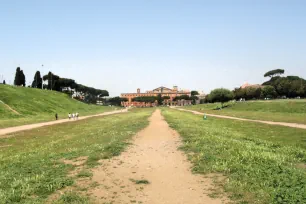The Circus Maximus was the largest stadium in ancient Rome. Popular chariot races were held here for almost a millennium. At one point the Circus could seat 250,000 people, one quarter of Rome’s population.

Chariot races were one of the Roman’s most popular forms of entertainment. Romulus, the first of Rome’s seven kings, is said to have held chariot races.
Early History
The origins of the Circus Maximus go back to the sixth century BC, when Tarquinius Priscus, the fifth king of Rome, created a track between the Palatine and Aventine hills. The first permanent starting gates were created in 329 BC. In 174 BC the gates were rebuilt, and seven wooden eggs were placed on top of the spina, the central wall in the arena. The eggs were used to count the number of laps; after each lap, one egg was removed. In 33 BC, seven bronze dolphins were added to the spina for the same purpose.
Wooden Stadiums
A fire in 31 BC, the first of three, destroyed the wooden structure. It was rebuilt by Emperor Augustus, who also added an imperial box on the Palatine Hill. A large obelisk from Heliopolis was added to the spina as a decoration. The obelisk can now be found at the center of the Piazza del Popolo. Another obelisk was added much later, in the fourth century.
A second fire, in 64 AD, which started in wooden shops at the bottom around the track, was the source of the fire that burned much of Rome during the reign of Emperor Nero.

The Marble Stadium
After yet another fire, the Circus was rebuilt by Trajan in 103 AD. The Roman Empire was at the height of its power, and the new Circus Maximus reflected this status. The Circus was now a stone construction, three stories high. The lower part of the cavea (seating area) was built in marble. The arena complex was now more than 600 meters long and 150 meters wide (2000 x 500 ft.).
Popular Events
The Circus Maximus was occasionally used for events such as processions or gladiator combats, but on most days only chariot races with quadrigae, pulled by four horses, were held here. The races themselves were wildly popular with people fanatically supporting one of the four factions: red, white, green and blue representing summer, winter, spring and autumn respectively. Bets were laid on one of the factions, and supporters of the different factions often clashed, sometimes resulting in deaths among the spectators.
The Last Race
The last race in the Circus Maximus was held in 549 AD, almost a millennium after the first races were held at this location. Today, only the layout of the original circus can be seen in what is now a large grassland. Most of the original structure was used as building material for medieval and Renaissance constructions.

